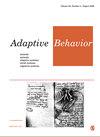Perceiving and creating atmospheres: how ecological-enactive cognition can explain and inform architectural practice
IF 1.3
4区 计算机科学
Q4 COMPUTER SCIENCE, ARTIFICIAL INTELLIGENCE
引用次数: 0
Abstract
The notion of atmosphere has taken prominence in contemporary architecture discourse, in which it is used mainly to denote the affective characteristic of inhabitable spaces. In this paper, we employ the ecological-enactive approach to cognition to explain how atmospheres are perceived and created. According to that approach, cognitive systems actively explore meaningful possibilities for action in their environments. We thereby construe the perception of atmospheres as the possibilities for being in certain moods by exploring what the place affords. The perception of atmospheres is, therefore, a meaningful activity that is ultimately related to the organism’s biological interests, which we argue, is a type of meaning that cannot be fully conveyed descriptively. From this, it seems to follow that architects cannot foresee the atmospheres of a place during the designing phase of their projects. We avoid this undesirable conclusion by evoking the material engagement theory and the situated aspect of cognitive performances. Accordingly, skillful architects can imagine the intended atmospheres of a place by creating what we call proto-atmospheres, which involves creatively thinking through and with their tools.感知和创造氛围:生态活动认知如何解释和告知建筑实践
氛围的概念在当代建筑话语中占有突出地位,它主要用于表示可居住空间的情感特征。在本文中,我们采用生态行为的认知方法来解释大气是如何感知和创造的。根据这种方法,认知系统积极探索环境中有意义的行动可能性。因此,我们将对氛围的感知解释为通过探索这个地方所提供的东西而处于某种情绪中的可能性。因此,对大气的感知是一种有意义的活动,它最终与生物体的生物利益有关,我们认为,这是一种无法完全描述的意义。由此看来,建筑师在项目的设计阶段似乎无法预见一个地方的氛围。我们通过唤起物质参与理论和认知表现的情境方面来避免这一不良结论。因此,熟练的建筑师可以通过创造我们所谓的原型氛围来想象一个地方的预期氛围,这需要创造性地思考和使用他们的工具。
本文章由计算机程序翻译,如有差异,请以英文原文为准。
求助全文
约1分钟内获得全文
求助全文
来源期刊

Adaptive Behavior
工程技术-计算机:人工智能
CiteScore
4.30
自引率
18.80%
发文量
34
审稿时长
>12 weeks
期刊介绍:
_Adaptive Behavior_ publishes articles on adaptive behaviour in living organisms and autonomous artificial systems. The official journal of the _International Society of Adaptive Behavior_, _Adaptive Behavior_, addresses topics such as perception and motor control, embodied cognition, learning and evolution, neural mechanisms, artificial intelligence, behavioral sequences, motivation and emotion, characterization of environments, decision making, collective and social behavior, navigation, foraging, communication and signalling.
Print ISSN: 1059-7123
 求助内容:
求助内容: 应助结果提醒方式:
应助结果提醒方式:


